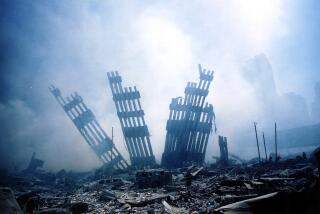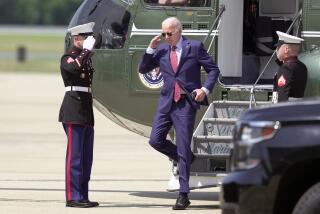Hussein Is No Match for the U.S. : Military: With the largest peacetime buildup in history and the best-trained and best-armed forces ever, how can American power be doubted?
Saudi Arabia has awakened to the real threat posed by Iraq, and U.S. forces are speeding to the Persian Gulf to help deter further aggression. But what if we are compelled to fight? Experts commenting in the media have displayed little confidence in U.S. military power. Such gloom is unwarranted because it ignores the massive capabilities of the United States, and dangerous because it could undermine Saudi Arabiaâs will and feed Saddam Husseinâs impudence.
Doubts about U.S. power are peculiar, since the United States has just completed the largest peacetime military buildup in its history and has the best-trained and best-armed forces ever. A main goal of that buildup was to be able to combat a Soviet attack in the Persian Gulf, while simultaneously fighting a major war in Europe. But with the revolution in Soviet foreign policy, the United States need not be concerned about a simultaneous challenge elsewhere; all of its military energies can be focused on the bandit dictator.
For the record:
12:00 a.m. Aug. 13, 1990 For the Record
Los Angeles Times Monday August 13, 1990 Home Edition Metro Part B Page 5 Column 1 Op Ed Desk 2 inches; 51 words Type of Material: Correction
Military strength--Due to a typographical error in a commentary Friday by Barry Posen on Iraqi and U.S. military strength, the number of tanks in the U.S. arsenal was understated. The number is 15,000. And a sentence on assistance by our European allies should have referred to large numbers of European merchant ships rather than large numbers of merchant marines.
Centcom, a unified U.S. command for the Persian Gulf Region, has assembled the necessary intelligence information and contingency plans; significant local operational experience was gained during the Kuwait tanker escort operation in 1988. While much has been made of Husseinâs 50 army divisions, 5,500 tanks and 500 combat aircraft, these numbers tell us little about his military capability against the United States of America--with its 1,500 tanks, 4,000 fighter aircraft and dozen deployable aircraft carriers.
The U.S. Rapid Deployment Force would be the foundation for the defense of Saudi Arabia: five Army and Marine divisions, three carrier battle groups and seven Air Force tactical fighter wings with roughly 750 combat aircraft and perhaps 500 tanks and 200 attack helicopters. There is sufficient sealift and airlift capability for the force to reach the gulf within 30 days. Army and Marine heavy equipment could be dispatched now and left on ships off the Arabian peninsula until needed. Personnel would follow by air. Thus there is no need to wait for an expanded Saudi invitation to start moving armored reinforcements.
A quiescent Soviet Union means that much more could be committed. The United States can deploy as many wings of fighter aircraft to the gulf as there are airfields on which to base them--and there are plenty. Similarly, armored forces from Europe could be redeployed to Saudi Arabia. The assistance of our European allies, and their large numbers of merchant marines, would permit the movement of perhaps two divisionsâ worth of equipment (600 tanks) in less than a month. Three additional carrier task forces--for a total of six --could deploy to the theater, and with the extra effort warranted by the seriousness of the threat, remain there for some time. Sufficient carriers would remain at home to provide a âsecond shiftâ in the event that the crisis dragged on.
How will theses force defeat Iraqâs vaunted 50-division army? Massive aerial combat power must be employed in concentrated hammer blows to smash Husseinâs air force, surface-to-surface missiles and chemical-weapon stocks, as soon as possible after combat begins: U.S. forceswould have a thousand aircraft; his largely obsolescent 500-plane air force, manned by pilots with no combat experience against a sophisticated aerial adversary, would not last long.
U.S. aircraft could then be switched to attacks on Iraqi armor and logistics units to blunt their capability and slow their advance. Without air cover or ground-based defenses, mechanized ground forces in desert areas are highly vulnerable to air attack--as the Israelis proved in 1967 and the Germans and the Allies proved in North Africa during World War II. Iraqâs mobile ground-based air defenses are limited, and have had little relevant experience. The Iraqi army has never had to organize logistical support over the long lines of communication required for an invasion of Saudi Arabia, (which is more than half-again the size of Alaska), much less do so under serious air attack.
Iraqâs army is battle-hardened, but its combat experience is largely in static warfare with Iranian light infantry (against the resurgence of whom they must still withhold considerable forces.) Most Iraqi divisions are little better armed than U.S. infantry units were during World War II. Most of their tanks are of 30-year-old designs. They have no experience as to what U.S. air power can do, nor of the fast-paced ground warfare conducted by U.S. armored, attack helicopter and heli-borne forces. Thus, the U.S. ground force outlined above, although smaller than the entire Iraqi army, should be able to block the forward movement of whatever portion of their forces the Iraqis might be able to move into Saudi Arabia and could, with the assistance of massive air support, destroy their cohesion and capability. Should the Saudi military, other Arab forces, or traditional U.S. allies participate actively in combat, Iraq would be in even greater trouble.
The United States thus has the forces to repel an Iraqi invasion of Saudi Arabia. The recent dispatch of U.S. land-based fighter aircraft to Saudi Arabia will effectively close Husseinâs âwindow of opportunityâ within a matter of days. They ought to be able to delay any Iraqi attack until the full reinforcement package arrives to defeat Husseinâs forces decisively.
A final note of caution. A military confrontation with Iraq would be a real war, and casualties could be high. To successfully defend âvital interestsâ from threats by major military powers we must be prepared to pay this price.
More to Read
Sign up for Essential California
The most important California stories and recommendations in your inbox every morning.
You may occasionally receive promotional content from the Los Angeles Times.










